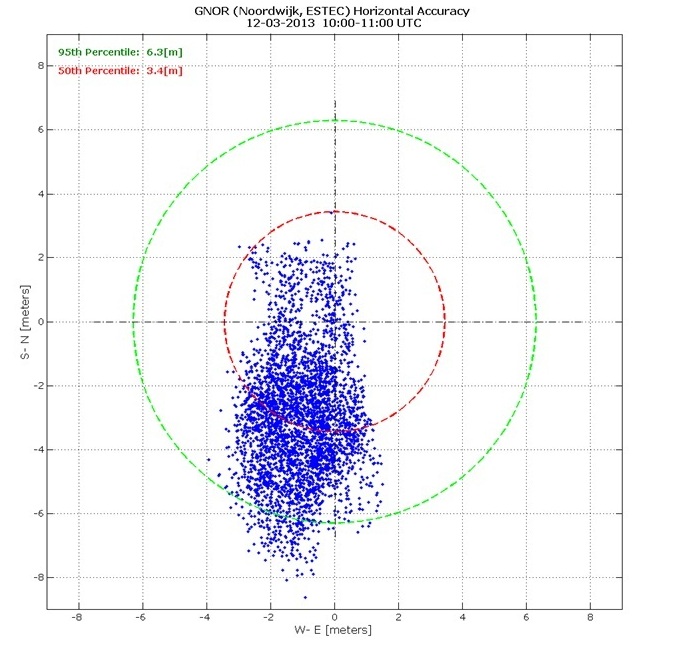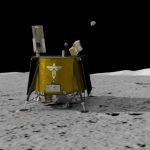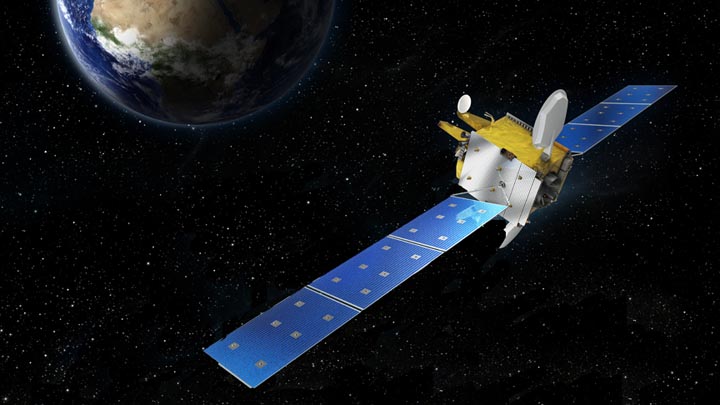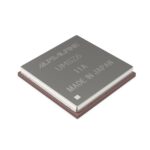 Measurements of individual Galileo horizontal position fixes performed for the first time using the four Galileo satellites in orbit plus the worldwide ground system between 1000 and 11:00 CET on Tuesday 12 March 2013, showing an overall horizontal accuracy over ESTEC in Noordwijk, the Netherlands, of 6.3 meters. ESA figure
Measurements of individual Galileo horizontal position fixes performed for the first time using the four Galileo satellites in orbit plus the worldwide ground system between 1000 and 11:00 CET on Tuesday 12 March 2013, showing an overall horizontal accuracy over ESTEC in Noordwijk, the Netherlands, of 6.3 meters. ESA figureThe European Space Agency (ESA) has announced a key milestone today (March 12, 2013) in the development of Europe’s GNSS program: the first determination of a ground location using the four Galileo satellites currently in orbit together with the system’s ground infrastructure.
This fundamental step confirms the Galileo system works as planned, according to ESA scientists.
The European Space Agency (ESA) has announced a key milestone today (March 12, 2013) in the development of Europe’s GNSS program: the first determination of a ground location using the four Galileo satellites currently in orbit together with the system’s ground infrastructure.
This fundamental step confirms the Galileo system works as planned, according to ESA scientists.
Signals from a minimum of four satellites are required to make a position fix in three dimensions. The first two space vehicles (SVs) were launched in October 2011, with two more following a year later.
“Once testing of the latest two satellites was complete, in recent weeks our effort focused on the generation of navigation messages and their dissemination to receivers on the ground,” explained Marco Falcone, ESA’s Galileo System Manager.
This first position fix of longitude, latitude, and altitude took place at the Navigation Laboratory at ESA’s technical center ESTEC, in Noordwijk, the Netherlands this morning. Positioning accuracy was between 10 and 15 meters — which reflects the limited infrastructure deployed so far, according to ESA.
This position fix relied on an entirely new European infrastructure, from the satellites in space to the two control centers in Italy and Germany linked to a global network of ground stations on European territory.
“The test of today has a dual significance: historical and technical, “notes Javier Benedicto, ESA’s Galileo project manager. “From the historical perspective, this is the first time ever that Europe has been able to determine a position on the ground using only its own independent navigation system, Galileo. From the technical perspective, generation of the Galileo navigation messages is an essential step for beginning the full validation activities, before starting the full deployment of the system by the end of this year.”
With only four satellites in orbit thus far, the entire Galileo constellation is only visible at the same time in a given location for a maximum two to three hours daily. This frequency will increase as more satellites join the first four SVs, along with extra ground stations coming online, eventually providing enough signals to support launch of Galileo’s early services now scheduled to begin at the end of 2014.
With the validation testing activities under way, users might experience breaks in the content of the navigation messages being broadcast. In the coming months the messages will be further elaborated to define the ‘offset’ between Galileo System Time and Coordinated Universal Time (UTC), enabling Galileo to be relied on for precision timing applications, as well as the Galileo to GPS Time Offset, ensuring interoperability with GPS. The ionospheric parameters for single-frequency users will be broadcast at a later stage to help improve real-time accuracy.
The definition phase and the development and in-orbit validation phase of the Galileo program were carried out by ESA and co-funded by ESA and the European Community.
The full operational capability (FOC) phase is managed and fully funded by the European Commission (EC). The EC and ESA have signed a delegation agreement under which ESA acts as design and procurement agent on behalf of the Commission.






